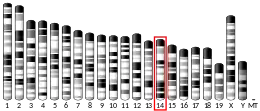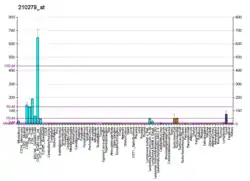N-Arachidonyl glycine receptor (NAGly receptor), also known as G protein-coupled receptor 18 (GPR18), is a protein that in humans is encoded by the GPR18 gene.[5][6] Along with the other previously "orphan" receptors GPR55 and GPR119, GPR18 has been found to be a receptor for endogenous lipid neurotransmitters, several of which also bind to cannabinoid receptors.[7][8][9] It has been found to be involved in the regulation of intraocular pressure.[10]
Research supports the hypothesis that GPR18 is the abnormal cannabidiol receptor and N-arachidonoyl glycine, the endogenous lipid metabolite of anandamide, initiates directed microglial migration in the CNS through activation of GPR18,[11] though recent evidence demonstrates that NAGly was not shown to be a GPR18 agonist in rat sympathetic neurons.[12]
Resolvin D2 (RvD2), a member of the specialized proresolving mediators (SPM) class of polyunsaturated fatty acid metabolites, is an activating ligand for GPR18; RvD2 and its activation of GPR18 contribute to the resolution of inflammatory responses as well as inflammation-based and other diseases in animal models and are proposed to do so in humans.[13] Furthermore, RvD2 is a metabolite of the omega-3 fatty acid, docosahexaenoic acid (DHA); the metabolism of DHA to RvD2 and RvD2's activation of GPR18 is proposed to one among many other mechanisms for the anti-inflammatory and other beneficial effects attributed to omega-3 fatty acid-rich diets[14]
Ligands
- Agonists
Ligands found to bind to GPR18 as agonists include:[11][15]
- N-Arachidonoylglycine (NAGly)
- Abnormal cannabidiol (Abn-CBD)
- AM-251 - partial agonist
- Cannabidiol - partial agonist
- CBG-DMH[16]
- O-1602
- Δ9-Tetrahydrocannabinol (Δ9-THC) - THC is actually a more potent agonist at GPR18 than at CB1 or CB2, with Ki of 0.96nM at GPR18, 8.1nM at GPR55, 25.1nM at CB1 and 35.2nM at CB2.[17]
- Anandamide (N-arachidonoyl ethanolamine, AEA)
- Arachidonylcyclopropylamide (ACPA)[18]
- Resolvin D2 (RvD2) [19]
- Antagonists
- Amauromine[20]
- O-1918
- CID-85469571[21]
References
- 1 2 3 GRCh38: Ensembl release 89: ENSG00000125245 - Ensembl, May 2017
- 1 2 3 GRCm38: Ensembl release 89: ENSMUSG00000050350 - Ensembl, May 2017
- ↑ "Human PubMed Reference:". National Center for Biotechnology Information, U.S. National Library of Medicine.
- ↑ "Mouse PubMed Reference:". National Center for Biotechnology Information, U.S. National Library of Medicine.
- ↑ Gantz I, Muraoka A, Yang YK, Samuelson LC, Zimmerman EM, Cook H, Yamada T (Sep 1997). "Cloning and chromosomal localization of a gene (GPR18) encoding a novel seven transmembrane receptor highly expressed in spleen and testis". Genomics. 42 (3): 462–6. doi:10.1006/geno.1997.4752. PMID 9205118.
- ↑ "Entrez Gene: GPR18 G protein-coupled receptor 18".
- ↑ Kohno M, Hasegawa H, Inoue A, Muraoka M, Miyazaki T, Oka K, Yasukawa M (September 2006). "Identification of N-arachidonylglycine as the endogenous ligand for orphan G-protein-coupled receptor GPR18". Biochem. Biophys. Res. Commun. 347 (3): 827–32. doi:10.1016/j.bbrc.2006.06.175. PMID 16844083.
- ↑ Burstein S (December 2008). "The elmiric acids: biologically active anandamide analogs". Neuropharmacology. 55 (8): 1259–64. doi:10.1016/j.neuropharm.2007.11.011. PMC 2621443. PMID 18187165.
- ↑ Bradshaw HB, Lee SH, McHugh D (September 2009). "Orphan endogenous lipids and orphan GPCRS: A good match". Prostaglandins Other Lipid Mediat. 89 (3–4): 131–4. doi:10.1016/j.prostaglandins.2009.04.006. PMC 2740803. PMID 19379823.
- ↑ Caldwell MD, Hu SS, Viswanathan S, Bradshaw H, Kelly ME, Straiker A (June 2013). "A GPR18-based signalling system regulates IOP in murine eye". British Journal of Pharmacology. 169 (4): 834–43. doi:10.1111/bph.12136. PMC 3687663. PMID 23461720.
- 1 2 McHugh D, Hu SS, Rimmerman N, Juknat A, Vogel Z, Walker JM, Bradshaw HB (2010). "N-arachidonoyl glycine, an abundant endogenous lipid, potently drives directed cellular migration through GPR18, the putative abnormal cannabidiol receptor". BMC Neurosci. 11: 44. doi:10.1186/1471-2202-11-44. PMC 2865488. PMID 20346144.
- ↑ Lu VB, Puhl HL, Ikeda SR (Jan 2013). "N-Arachidonyl glycine does not activate G protein-coupled receptor 18 signaling via canonical pathways". Molecular Pharmacology. 83 (1): 267–82. doi:10.1124/mol.112.081182. PMC 3533477. PMID 23104136.
- ↑ Shinohara M, Serhan CN (2016). "Novel Endogenous Proresolving Molecules:Essential Fatty Acid-Derived and Gaseous Mediators in the Resolution of Inflammation". Journal of Atherosclerosis and Thrombosis. 23 (6): 655–64. doi:10.5551/jat.33928. PMC 7399282. PMID 27052783.
- ↑ Calder PC (2015). "Marine omega-3 fatty acids and inflammatory processes: Effects, mechanisms and clinical relevance". Biochimica et Biophysica Acta (BBA) - Molecular and Cell Biology of Lipids. 1851 (4): 469–84. doi:10.1016/j.bbalip.2014.08.010. PMID 25149823.
- ↑ McHugh D, Page J, Dunn E, Bradshaw HB (May 2011). "Δ(9) -THC and N-arachidonyl glycine are full agonists at GPR18 and cause migration in the human endometrial cell line, HEC-1B". Br J Pharmacol. 165 (8): 2414–24. doi:10.1111/j.1476-5381.2011.01497.x. PMC 3423258. PMID 21595653.
- ↑ Szczesniak AM, Maor Y, Robertson H, Hung O, Kelly ME (October 2011). "Nonpsychotropic cannabinoids, abnormal cannabidiol and canabigerol-dimethyl heptyl, act at novel cannabinoid receptors to reduce intraocular pressure". Journal of Ocular Pharmacology and Therapeutics. 27 (5): 427–35. doi:10.1089/jop.2011.0041. PMID 21770780.
- ↑ Ashton JC (2012). "The atypical cannabinoid o-1602: Targets, actions, and the central nervous system". Central Nervous System Agents in Medicinal Chemistry. 12 (3): 233–239. doi:10.2174/187152412802430156. PMID 22831390.
- ↑ McHugh D, Bradshaw HB (2012). "GPR18 and NAGly Signaling: New Members of the Endocannabinoid Family or Distant Cousins?". In Abood ME (ed.). endoCANNABINOIDS: actions at non-CB1/CB2 cannabinoid receptors. New York: Springer. ISBN 978-1-4614-4668-2.
- ↑ Chiang N, Dalli J, Colas RA, Serhan CN (2015). "Identification of Resolvin D2 Receptor Mediating Resolution of Infections and Organ Protection" (PDF). J. Exp. Med. 212 (8): 1203–1217. doi:10.1084/jem.20150225. PMC 4516788. PMID 26195725.
- ↑ Schoeder CT, Kaleta M, Mahardhika AB, Olejarz-Maciej A, Łażewska D, Kieć-Kononowicz K, Müller CE (July 2018). "Structure-activity relationships of imidazothiazinones and analogs as antagonists of the cannabinoid-activated orphan G protein-coupled receptor GPR18". European Journal of Medicinal Chemistry. 155: 381–397. doi:10.1016/j.ejmech.2018.05.050. PMID 29902723. S2CID 49214747.
- ↑ Rempel V, Atzler K, Behrenswerth A, Karcz T, Schoeder C, Hinz S, et al. (2014). "Bicyclic imidazole-4-one derivatives: a new class of antagonists for the orphan G protein-coupled receptors GPR18 and GPR55". Med. Chem. Commun. 5 (5): 632–649. doi:10.1039/C3MD00394A.
Further reading
- Christian SL, McDonough J, Liu Cy CY, Shaikh S, Vlamakis V, Badner JA, Chakravarti A, Gershon ES (2002). "An evaluation of the assembly of an approximately 15-Mb region on human chromosome 13q32-q33 linked to bipolar disorder and schizophrenia". Genomics. 79 (5): 635–56. doi:10.1006/geno.2002.6765. PMID 11991713.
- Kohno M, Hasegawa H, Inoue A, Muraoka M, Miyazaki T, Oka K, Yasukawa M (2006). "Identification of N-arachidonylglycine as the endogenous ligand for orphan G-protein-coupled receptor GPR18". Biochem. Biophys. Res. Commun. 347 (3): 827–32. doi:10.1016/j.bbrc.2006.06.175. PMID 16844083.




